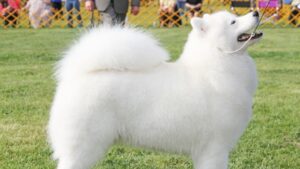
Claire O’Neill | Bark Bark Samoyeds
Claire O’Neill is the breeder behind Bark Bark Samoyeds. Read about the kennel’s beginnings, champion dogs, Samoyed puppies, photos & more!
Home » Dog Breeds » Samoyed Dog Breed
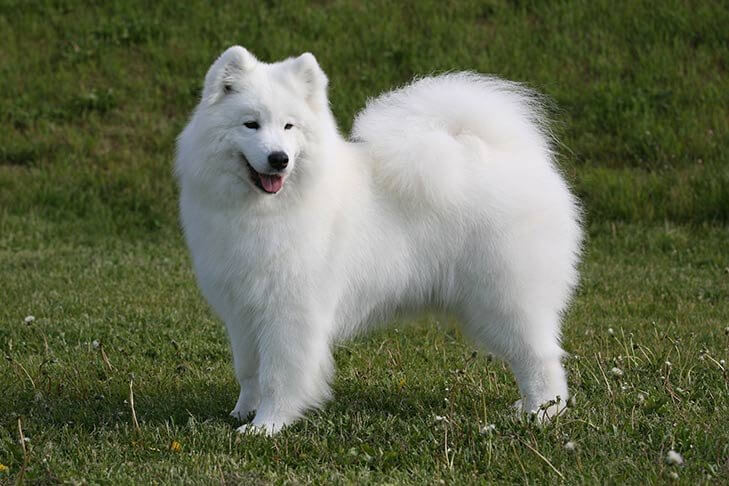
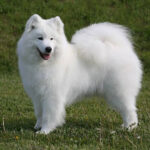
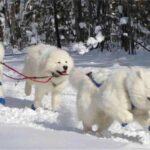
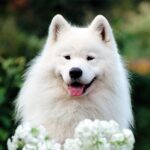
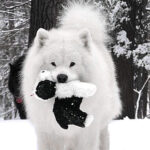
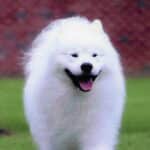
The Samoyed, affectionately known as the “Sammy,” is renowned for its amiable demeanor, striking white coat, and unmistakable smile. Originating from the harsh, cold environments of Siberia, this double-coated dog was historically bred by the Samoyedic people for herding reindeer, hunting, and hauling sleds. Its plush coat not only serves as protection against cold temperatures, it is also a hallmark of the breed. The Sammy possesses an innate affability, making it a treasured companion for families and active singles. Furthermore, the Samoyed’s resilience and versatility enable it to excel in a variety of roles, from sledding and herding to that of a loyal and loving companion. A glance into the eyes of a Samoyed reveals the breed’s gentle, alert, and intelligent nature, attributes that have endeared it to many around the globe.
Working
19 – 23.5 Inches
35 – 65 Pounds
12 – 14 Years
| Country of Origin | Siberia |
|---|---|
| Bred For | Herding Reindeer, Sled Hauling, Companionship |
| Known For | Brilliant White Coat, “Sammy Smile,” Gentle and Affable Nature, Resilience in Cold Climates |
| Popularity | Moderate |
| Temperament | Friendly, Gentle, Adaptable |
| Activities | Hauling, Herding, Conformation Shows, Dog Sports |
The story of the Samoyed dates back to the ancient tribes of the Siberian north. These dogs are named after the Samoyedic people, a group of semi-nomadic tribes from Northern Siberia who relied heavily on these canines for various tasks essential for their survival.
Originating on the vast, frigid plains of Siberia, the primary purpose of the Samoyed was far more than just companionship. These dogs were versatile workers. They herded reindeer, assisted in hunting, and most importantly, pulled sleds across the expansive snowy terrains. Their close relationship with the Samoyedic people, however, wasn’t just out of necessity; they were often regarded as family members, sometimes even sharing sleeping quarters with their human counterparts, providing warmth during the bitterly cold nights.
This bond between the people and their Samoyeds created a dog with an exceptional temperament: friendly, sociable, and eager to cooperate. The breed’s white, fluffy coat wasn’t just for show—it was a crucial adaptation to the icy Siberian weather, providing insulation against the cold and reflecting heat during the brief summer months.
The Samoyed began to gain recognition outside of Siberia in the late 18th and early 19th centuries when Europeans started to venture into the polar regions. These explorers recognized the invaluable skills of the breed, especially their sled-pulling capabilities, and brought them back home and, eventually, to other parts of the world.
In terms of official recognition, the American Kennel Club (AKC) officially recognized the Samoyed in 1906, while The Royal Kennel Club (UK) granted recognition a bit earlier, in the late 19th century. The Fédération Cynologique Internationale (FCI) also lists the Samoyed among its many recognized breeds.
From its beginnings in the snow-covered landscapes of Siberia to the show rings and living rooms around the globe, the Samoyed has traveled a long and rich journey, carrying its signature smile every step of the way.
A mature male Samoyed stands between 21 and 23.5 inches tall at the shoulder, while females typically range from 19 to 21 inches in height.
Weight can vary based on size, but males generally weigh between 45 and 65 pounds, with females falling in the range of 35 to 50 pounds.
The Samoyed presents a picture of balance, strength, and harmony. Neither racy nor cobby, the breed’s body is only slightly longer than it is tall. This proportion ensures efficient speed, agility, and endurance. Its substance is evident in its strong bone and muscular build, displaying power without any hint of clumsiness. A deep chest and well-sprung ribs are vital for lung capacity in harsh conditions, while the strong back and loins showcase the breed’s herding and sledding heritage.
Texture: The Samoyed’s glistening coat is notably plush, featuring a dense double layer. The coat not only serves an aesthetic purpose (it can positively sparkle), it also provides the dog with essential protection against harsh and cold conditions. The coat is dense and weather-resistant, with a ruff around the neck and shoulders, and a plume on the tail. The undercoat is a kind of wool, which can be spun into yarn and used to knit beautiful woven garments.
| Standard Color | |
|---|---|
| White | ee |
| Biscuit | ee |
| Cream | ee |
| White & Biscuit | ee |
Markings: Irregular patches of color may appear on white & biscuit coats.
A Note About Color: Samoyeds do not possess specific markings as such; however, the coat of white & biscuit dogs may present irregular patches of color, particularly on the body and ears. The biscuit coloration can appear in a dog as it matures, and the color tends to darken with age. Brindle, merle, and tri-colored coats are unacceptable in the breed.
The tail of the Samoyed is one of the breed’s signature hallmarks. Positioned just below the level of the topline, the tail arches up and over the back or gracefully drapes to the side when the dog is in motion or is particularly alert. During moments of relaxation, it is not uncommon for the tail to hang downward. Its moderate length typically allows the tip of the tail to reach the hock or slightly below it. A distinguishing feature of the tail is its profusion of long, harsh hairs, which bestows upon it a lush, bushy appearance that provides protection from the cold. Outdoors, the tail is used to cover the head when the dog is sleeping as a way of warming the air that it breathes.
Sharing life with a Samoyed is a commitment that promises joy, companionship, and the occasional flurry of white hair around the house. As with any breed, understanding the Sammy’s unique requirements will go a long way towards ensuring a harmonious relationship and a well-cared-for companion.
The Samoyed, while robust and hearty due to its Siberian origins, comes with a set of health considerations that prospective owners should be aware of.
Lifespan: The average lifespan of a Samoyed ranges from 12 to 14 years, but with proper care, regular check-ups, and a balanced diet, many Sammies can thrive beyond these years.
While Samoyeds are generally hardy canines, like all breeds and mixed breeds, they can be predisposed to certain health concerns. Some of the more common issues include:
Regular check-ups with a veterinarian can help to identify and manage issues early on. It’s beneficial for Samoyed owners to be proactive about their dog’s health, scheduling routine screenings and being alert to any signs of distress or abnormal behavior.
Spending time with a Samoyed is to embrace a breed that’s known for its friendly and gentle demeanor. The Sammie is the epitome of the loyal and loving companion, making it a cherished family member in homes around the world.
For those new to dog ownership, Samoyeds can present a mix of joy and challenges. The breed’s sociable nature means the Sammy thrives in environments where it can be included in family activities. These dogs can be sensitive to their surroundings, picking up on their owners’ moods, which makes them attuned as companions but can also lead them to becoming slightly anxious in tense situations.
Being pack animals, Samoyeds enjoy the company of other dogs; however, their history as reindeer herders means early socialization is beneficial to ensure they coexist harmoniously with smaller pets. They’re generally great with young children, offering a mix of playfulness and patience. Visitors to a Sammie household are often greeted warmly, as these dogs are typically friendly toward strangers.
The strong bond they form with their human families, however, means Samoyeds don’t particularly enjoy being left alone for extended periods. Prolonged isolation can result in feelings of separation anxiety or lead to mischievous behaviors.
Proper nutrition is paramount for the Samoyed’s vitality and longevity. The breed’s dietary needs, however, will differ depending on each dog’s life stage.
For Sammie puppies, a diet that supports growth and development is essential. Puppy-specific foods are designed to provide the nutrients necessary for burgeoning bones, muscles, and organs. As the pups transition into adulthood, around the age of one, the focus shifts to maintaining a healthy weight and supporting their active lifestyle.
An average adult Samoyed typically requires between 2.5 to 3 cups of high-quality dry dog food daily, split into two meals. However, this amount can vary based on factors like age, metabolism, activity level, and overall health. It’s always crucial to consult with a veterinarian to determine the optimal feeding regimen for each individual dog.
Feeding charts, often available on dog food packaging, can provide general guidelines. However, observing a Samoyed’s condition and energy levels is key. Adjustments to a dog’s diet might be needed based on weight fluctuations and changes in activity levels.
It’s also worth noting that Samoyeds, with their thick coats, can be susceptible to overheating. Fresh water should always be readily available, especially after meals and following any strenuous physical activity.
Training a Samoyed requires patience, consistency, and an understanding of the breed’s unique character traits. Being an intelligent breed, Samoyeds are quick learners, but their independent streak can sometimes be mistaken for stubbornness. It’s essential to start training early, ideally during puppyhood, to make sure the puppy grows up to become a well-mannered adult.
Samoyeds respond best to positive reinforcement techniques. Harsh corrections or punitive methods can harm the sensitive bond shared between each dog and their person, and might even lead to behavioral issues. Instead, using rewards like treats, praise, or play can motivate them and make training sessions enjoyable for everyone.
While they aren’t known for being excessively vocal, Samoyeds do have a range of barks and howls, often employed to communicate or grab attention. Early training can help to manage any excessive barking.
Given their historical roles as herders and sled dogs, Samoyeds possess an inherent desire to work. This translates into a moderate potential for wanderlust. It’s crucial, therefore, to make sure that fencing in the yard is secure and to always keep the dog on a leash during walks to prevent any impromptu adventures.
Samoyeds, owing to their past, also have a predation instinct. While this doesn’t necessarily translate to aggressive behavior, it’s wise to be cautious when introducing these dogs to smaller animals and to supervise all interactions.
Ultimately, with the right approach, training a Samoyed can be a rewarding experience, paving the way for a harmonious relationship for years to come.
A glimpse into the history of the Samoyed quickly reveals why exercise is pivotal to the well-being of this breed. Originally bred to herd reindeer and pull sleds across the vast snowy landscapes of Siberia, these dogs possess a reservoir of energy and endurance.
| Energy Level | High |
|---|---|
| Exercise Requirements | 1-2 Hours/Day (Minimum), Daily Walks, Regular Exercise, Vigorous Running, Playing with Another Dog, Mental Stimulation |
Incorporating regular exercise into a Samoyed’s routine is not just about keeping the dog physically fit; it’s also about ensuring its mental well-being. Without ample activity, a Samoyed can become bored, leading to undesirable behaviors like digging or chewing.
Daily walks are essential, but for Samoyeds, merely walking might not be enough. Sammies thrive on more engaging activities like running, playing fetch, or even participating in dog sports like Agility or Obedience Trials. Winter sports, such as sledding or skijoring, can also be a delightful way for them to burn off energy.
It’s also worth noting that while Samoyeds are playful and often retain a puppy-like enthusiasm well into adulthood, their exercise needs can vary. Monitoring their enthusiasm and stamina, especially as they age, can help to determine the right amount and intensity of activity.
Incorporating interactive toys and puzzle feeders can further stimulate their minds, providing a wholesome balance between physical activity and cognitive challenges.
Samoyeds are often revered for their striking white coat, but this beauty comes with its own set of responsibilities. Grooming a Samoyed is not just about aesthetics; it’s an essential component of the dog’s overall health and well-being.
| Coat Type | Double, Dense Undercoat, Straight Harsh Outer Coat, Weather-Resistant |
|---|---|
| Grooming Requirements | Weekly Brushing, Occasional Bathing, Trimming Around the Feet, Routine Ear Cleaning, Periodic Nail Trimming, Regular Tooth Brushing |
The coat of a Samoyed is dense and double-layered. The undercoat is soft and wooly, while the outer coat consists of longer, harsher hairs. This combination helps to protect the dog from harsh weather conditions, but it also necessitates regular grooming.
Brushing a Samoyed several times a week is a must. This routine not only keeps the coat looking its best, it also helps with reducing the amount of hair around the house. More than that, brushing helps to distribute the natural oils of the dog’s skin, ensuring a healthy, sparkling appearance, and it allows for the early detection of potential skin issues and parasites.
While Samoyeds are often sometimes considered to be among the breeds that shed less than some other dogs, they do “blow” their undercoat, especially during the change of seasons. During these periods, daily brushing is necessary to help with managing the increased shedding.
Bathing a Samoyed isn’t a frequent requirement, and in many cases, a good brushing alone will remove dirt and debris effectively. However, when a bath is necessary, using a dog-specific shampoo and making sure to thoroughly rinse and dry the coat are crucial. The breed’s thick coat can trap moisture close to the skin, which can lead to skin irritations if not dried properly.
Regular check-ups of their ears, teeth, and nails complete the grooming regimen, ensuring that the Samoyed remains not just beautiful but also brilliantly healthy from nose to tail.
Living with a Samoyed is a unique experience, shaped by the breed’s history, temperament, and physical attributes. As much as these dogs are cherished for their playful nature and radiant smiles, prospective owners should be well-versed in the specific needs of this breed in order to provide for a harmonious home life.
Considering their origin in the frigid climates of Siberia, Samoyeds are best-suited for cooler environments. Their thick double coat provides ample insulation against cold weather, making them the perfect companions for snowy adventures or outdoor activities during the winter months. However, the same coat can be a challenge in hotter climates. In warmer regions or during summer months, it’s essential to provide Samoyeds with a cool, shaded environment and to make sure outdoor activities are scheduled during the cooler parts of the day.
When it comes to accommodations, while Samoyeds can adapt to apartment living, they thrive better in homes with spacious yards where they can play and expend their energy. If residing in an apartment, it’s imperative to be sure they’re allowed ample outdoor time for both mental and physical stimulation.
Samoyeds are social creatures. Their loyalty and attachment to their human family mean they prefer to be involved in family activities rather than being left outside or isolated for extended periods. Without regular interaction and stimulation, a Samoyed can develop feelings of loneliness or even display destructive behaviors.
The arrival of a Samoyed puppy into one’s life is nothing short of enchanting. With its fluffy white coat, playful antics, and ever-curious eyes, the Sammy pup brings with it a whirlwind of joy and excitement. Samoyed puppies are balls of energy, eager to explore their surroundings and bond with their human families.
The first few months of a Samoyed puppy’s life are critical, laying the foundation for a lifetime bonded with its favorite people. Navigating this stage requires a blend of love, understanding, and knowledge. For example, when it comes to the pup’s nutrition, a high-quality puppy formula will ensure the pup receives all the necessary nutrients needed for steady growth. Monitoring the diet is vital at this time, as a rapid increase in weight can lead to potential skeletal issues later in life.
As Samoyed puppies venture into their new surroundings, introducing them to diverse sights, sounds, and experiences is key. Early socialization helps to craft confident and well-rounded adult dogs, shaping their reactions and temperament for years to come. Concurrently, their innate intelligence can make training sessions an adventure. While pups might indulge in playful mischief at times, consistent obedience training and positive reinforcement will foster trust, ensuring they grow into well-disciplined adult dogs.
Health is another important focus during this stage. Regular veterinary check-ups, timely vaccinations, and routine deworming protocols will greatly benefit the Sammy puppy. And although its iconic fluffy coat isn’t fully developed yet, early grooming sessions will acquaint it with the process, setting the stage for a stress-free grooming regimen as an adult.
Samoyed puppies brim with energy, so balancing their exercise needs is essential. Too much activity can be hard on their growth plates and joints, but they do need play and exploration to satisfy their curiosity. Safe toys and controlled play sessions help with striking this balance.
Lastly, providing a safe environment for the Samoyed puppy is of utmost importance. Puppy-proofing living spaces, removing potential hazards, and designating a comfortable resting spot will give the pup a sense of security, letting it know it is truly home.
The Samoyed is more than just a visual delight. Hailing from the frosty terrains of Siberia, this dog embodies eagerness, vigor and adaptability. Over the years, dogs of this breed have showcased their skills in a range of activities and dog sports, underscoring the breed’s diverse talents.
The Samoyed’s spectrum of capabilities is vast. Engaging this dog in various activities will not only highlight its many talents, it will also address the Sammy’s need for mental engagement and physical exertion.
The Samoyed is recognized by the world’s leading registries and kennel organizations, which categorize the breed into a specific Group based on its unique characteristics. This breed is recognized worldwide under the following Group designations:
| Organization | Group Designation |
|---|---|
| AKC (American Kennel Club) | Working |
| UKC (United Kennel Club) | Northern Breed |
| CKC (Canadian Kennel Club) | Working |
| ANKC (Australian National Kennel Council) | Utility |
| RKC (The Royal Kennel Club) | Working |
| FCI (Fédération Cynologique Internationale) | Group 5 – Spitz and Primitive types; Section 1 – Nordic Sledge Dogs |
The ideal Samoyed is described by a Breed Standard that is approved by each of the world’s leading registries and kennel organizations. The Breed Standards for this breed may be found in the following links:
| Organization | Breed Standard |
|---|---|
| American Kennel Club | AKC Samoyed Breed Standard |
| United Kennel Club | UKC Samoyed Breed Standard |
| Canadian Kennel Club | CKC Samoyed Breed Standard |
| Australian National Kennel Council | ANKC Samoyed Breed Standard |
| The Royal Kennel Club | RKC Samoyed Breed Standard |
| Fédération Cynologique Internationale | FCI Samoyed Breed Standard |
The world of purebred dogs is enriched and supported by many devoted breed clubs, organizations dedicated to the betterment and preservation of specific breeds. For the Samoyed, several national clubs play a pivotal role in maintaining Breed Standards, organizing events, and disseminating crucial information about the breed to members and potential owners alike.
In the United States, the Samoyed Club of America, Inc. stands as the nation’s foremost organization. Founded in 1923, this club remains committed to the Samoyed breed, ensuring the standards set by the club are upheld, promoting responsible breeding, and organizing National Specialty shows and events.
In Canada, the Samoyed Association of Canada takes the lead in representing and serving the breed. Like its American counterpart, this association is dedicated to the welfare of the breed, fostering education and hosting events that celebrate the unique characteristics of these snowy-coated dogs.
In the United Kingdom, the Samoyed Association is the primary organization for enthusiasts of the breed. Established in 1920, the association not only offers a platform for breeders and owners to connect, it also actively champions the betterment of the breed throughout the British Isles.
Membership or affiliation with these clubs can offer Samoyed enthusiasts access to a wealth of knowledge, regional and national events, and a community that shares a common love for this beautiful breed.
Rescue groups play an invaluable role in the canine community, providing shelter, care, and new beginnings for dogs in need. For the Samoyed, specific rescue organizations are dedicated to the well-being and rehoming of these snowy-coated companions.
In the United States, the Samoyed Rescue Alliance is an umbrella organization that encompasses various regional Samoyed rescue groups. The organization’s mission is not only to provide homes for Samoyeds in need but also to educate potential owners about the breed, ensuring that every Sammy finds a loving and well-informed home.
For those in the United Kingdom, the Samoyed Rescue Society offers support, rehoming services, and education for individuals looking to adopt. Established over 30 years ago, this society is passionate about providing an opportunity for every Samoyed in the UK to have a bright future in a loving home.
Yes, Samoyeds shed. These dogs have a thick, double coat that sheds heavily, especially during shedding seasons in the spring and fall.
No coated dog is truly hypoallergenic, but some breeds are better suited for people with allergies than others. Because they have a thick double coat that sheds regularly, Samoyeds can spread more dander around, which can be problematic for allergy sufferers. Additionally, the breed produces a specific protein that can be an allergen to some people.
Male Samoyeds typically weigh 45-65 pounds and stand about 21-23.5 inches tall at the shoulder. Females usually weigh between 35 and 50 pounds and have a height of 19-21 inches.
Samoyeds are generally friendly, affable companions. They’re not known for being problematic with other dogs, but, like all dogs, individual temperaments can vary. Proper socialization and training from a young age are essential to ensure a well-behaved and sociable adult Sammy.
On average, Samoyeds have a lifespan of 12 to 14 years, although some can live longer with proper care, a balanced diet, and regular vet check-ups.
Samoyeds originated in Siberia and were bred by the Samoyedic people. They were used for various tasks, including herding reindeer and pulling sleds.
Samoyeds typically have a friendly disposition and they can get along with cats, if introduced properly and socialized from a young age. However, as with any dog, it’s essential to monitor interactions and ensure that both the dog and cat feel safe and comfortable.
Yes, Samoyeds are known for being excellent family dogs. They are typically friendly and gentle, and they’re often good with children. They are also quite playful and social, which makes them a wonderful choice for many families.
Samoyeds are known for their friendly and sociable nature. They don’t typically bond exclusively with one individual. Instead, they often spread their love and attention evenly among all family members, making them excellent family pets.
Samoyeds are social dogs and thrive on companionship. If left alone for extended periods, a Sammy can become bored, anxious, or even depressed. This can lead to undesirable behaviors such as excessive barking, chewing, or digging. It’s best to provide the Samoyed with ample interaction and activity if it’s going to be expected to be alone for any length of time, and a companion or pet-sitter can also help to keep the dog from becoming bored and lonely.
Samoyeds can be quite vocal. They have a range of barks and “talks” that they use to communicate their feelings and needs. While they don’t typically bark without reason, they will alert their owners to strangers or unusual noises. Proper training from a young age can help to manage their vocalizations.
Samoyeds are considered high maintenance in terms of grooming. Their thick, double coat requires regular brushing to prevent matting and to manage shedding, especially during periods of extreme coat loss. In terms of exercise, these dogs also need regular activity to keep them mentally and physically stimulated, as the Sammy is an energetic breed with working origins. Proper care, training, and socialization are also crucial to ensure these active and outgoing dogs are well-behaved and well-adjusted as pets and companions.

Claire O’Neill is the breeder behind Bark Bark Samoyeds. Read about the kennel’s beginnings, champion dogs, Samoyed puppies, photos & more!
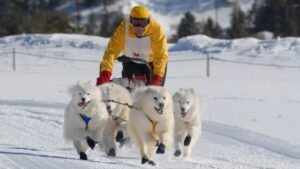
Explore the working Samoyed program, preserving the breed’s capabilities through activities like sledding, carting skijoring, and much more.
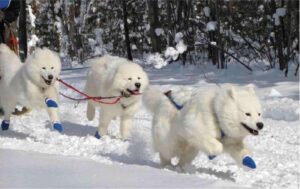
Breeder’s perspective on how the Samoyed breed is judged in the AKC conformation show ring based on the Samoyed’s original purpose.

Ringside photos and insights from the judges of the Samoyed Club of America National Specialty, which was held on October 3–8, 2022, in CA.
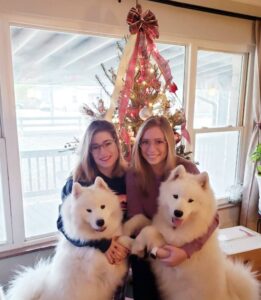
Interview with Working Group Breeders Terri & Rachel Sigulinsky – Where do we live? How many years in dogs? How many years as breeders?
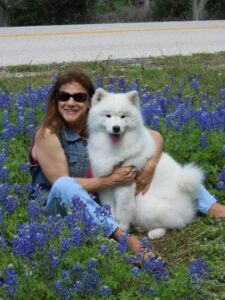
Interview with Working Group Breeder Joan Liebes – I purchased my first Samoyed and attended my first dog show in 1968. Along with my mother
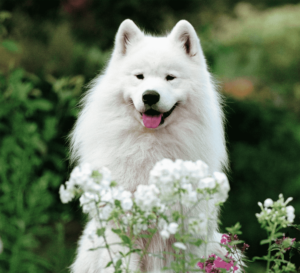
The Samoyed is an Arctic breed that lived and thrived around the Arctic Circle where temperatures could plunge to -50 degrees during the
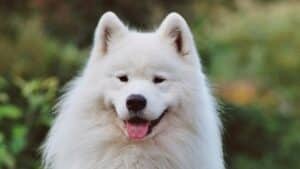
Explore Samoyed’s ancient roots and evolution into a cherished family companion. A journey through time and loyalty.

Claire O’Neill is the breeder behind Bark Bark Samoyeds. Read about the kennel’s beginnings, champion dogs, Samoyed puppies, photos & more!

Explore the working Samoyed program, preserving the breed’s capabilities through activities like sledding, carting skijoring, and much more.

Breeder’s perspective on how the Samoyed breed is judged in the AKC conformation show ring based on the Samoyed’s original purpose.

Ringside photos and insights from the judges of the Samoyed Club of America National Specialty, which was held on October 3–8, 2022, in CA.

Interview with Working Group Breeders Terri & Rachel Sigulinsky – Where do we live? How many years in dogs? How many years as breeders?

Interview with Working Group Breeder Joan Liebes – I purchased my first Samoyed and attended my first dog show in 1968. Along with my mother

The Samoyed is an Arctic breed that lived and thrived around the Arctic Circle where temperatures could plunge to -50 degrees during the

Explore Samoyed’s ancient roots and evolution into a cherished family companion. A journey through time and loyalty.
The best way to ensure a long and happy relationship with a purebred dog is to purchase one from a responsible breeder. Not sure where to begin?
Contact the National Parent Club’s Breeder Referral Program, which is listed on the AKC Breeder Referral Contacts page.
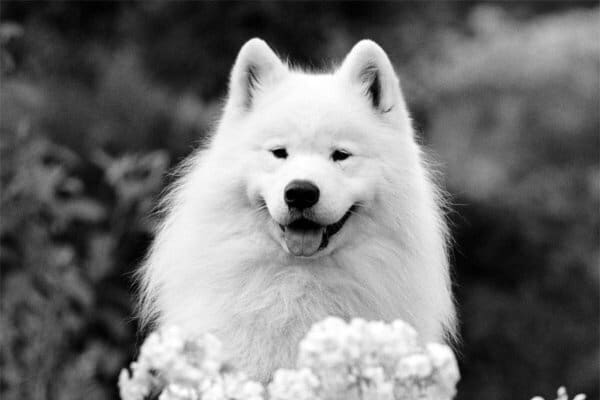

"*" indicates required fields
Showsight Magazine–the world’s most influential purebred dog publication since 1992. Each issue reaches a global audience dedicated to preserving the history and health of purpose bred dogs. Filled with award-winning editorial focused on news and insights from the dog show community, top breeders, handlers, AKC Judges, and more!